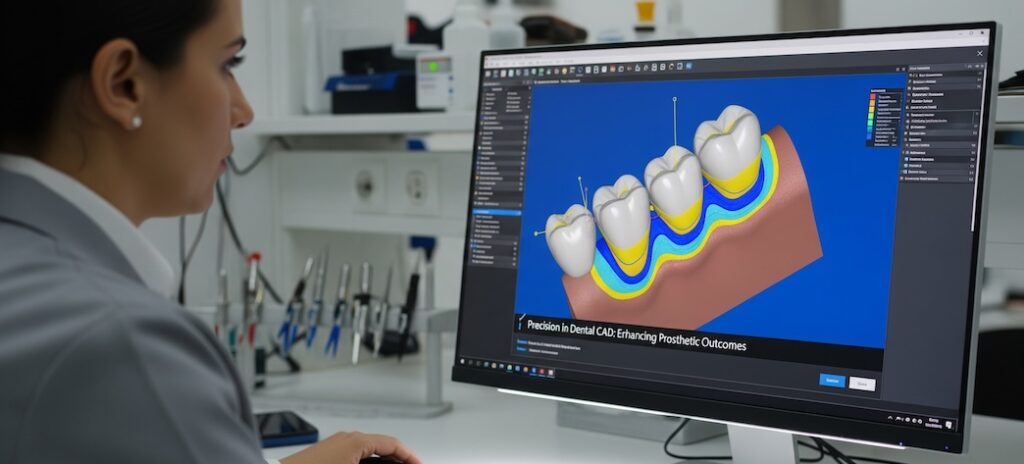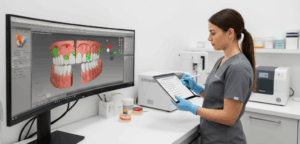In the world of digital dentistry, the phrase “not all STL files are created equal” resonates with a fundamental truth. An STL file, on its own, is just a set of geometric data. Its true value lies not only in the quality of the CAD design it represents, but in the quality of the scan it originates from. At WeCAD4You, our lab technicians face this reality daily: if an STL file lacks definition and clarity of the preparations, it’s like working in the dark. We know that a well-done CAD design, built on a quality file, is the cornerstone of a successful prosthesis, while a poor one can lead to clinical failures and a waste of time and resources.
But how do you measure the quality of a dental CAD design? It’s not just about the prosthesis “looking good” on a screen. Quality is defined by a set of rigorous technical criteria that directly impact the final outcome for the patient.

The High-Quality CAD design checklist
A first-class CAD design must meet the following points, which our WeCAD4You technicians meticulously review to ensure excellence in every project:
- Marginal Fit: This is, without a doubt, the most critical criterion. A good design must have a perfect fit at the margins of the preparation, with no gaps or over-contours. A poor fit can cause microleakage, postoperative sensitivity, and, in the long term, secondary caries.
- Minimum and Maximum Thickness: The restoration material (zirconia, E.max, etc.) requires a minimum thickness to be strong and a maximum to avoid being too bulky. A quality design not only respects these specifications but also adapts to the manufacturing needs of each client. It’s crucial to ensure compliance with the minimum thickness parameters provided to us, guaranteeing each design is optimized for the durability of the prosthesis and its compatibility with the patient’s occlusion.
- Anatomy and Morphology: The restoration should replicate the shape, contours, and textures of a natural tooth. This isn’t just for aesthetics, but also for function. A correct anatomical design ensures a stable occlusion and proper distribution of masticatory forces. To achieve this, a high-quality design considers the patient’s specific anatomy, aiming to replicate homologous or adjacent teeth. This allows us to select the library most similar to the patient’s dentition and guarantee an optimal result.
- Interproximal Contact Points: Contacts must be firm but not excessive. A contact point that is too tight can make cementation difficult and cause discomfort, while a weak one can lead to food impaction.
- Occlusion Technique: The design must integrate perfectly with the patient’s occlusion. This involves verifying the correct relationship with the opposing tooth in centric and eccentric movements to prevent interferences that could cause fractures or problems with the temporomandibular joint (TMJ). For this reason, at WeCAD4You, all our designs are virtually articulated, aiming to fulfill not just the aesthetics but the complete functionality of every prosthesis designed.
- Cementation Strategy: The design must account for the necessary space for cement or adhesive. A design with too little space can compromise adhesion, and excessive space can cause failures.
- Connector Location (for bridges): In the case of bridges, the connectors must be robust enough to withstand masticatory forces, respecting the appropriate thickness and shape for the material to be used.
Common errors and their clinical consequences
Ignoring any of the above criteria can lead to a series of serious problems that impact the dental technician, the clinic, and, most importantly, the patient:
- Fit problems: Result in rework, additional costs, and frustration. Clinically, they can lead to restoration failure.
- Poor geometry: If the design doesn’t respect the correct anatomical shapes, it can lead to an unstable occlusion, which may cause fractures and TMJ problems.
- Incorrect thickness: A design that is too thin will fracture under load, while one that is too thick can compromise space and aesthetics.
- Incorrect contact points: Can lead to difficulties for the clinician when trying the prosthesis. A weak contact results in food retention and a risk of periodontal disease.
All of this can be mitigated if we have precise information about the manufacturing parameters of each client, which depend on their equipment (scanners, 3D printers, milling machines) and the restorative material they will use. Therefore, the success of each case is a team effort that requires fluid communication between the clinician and the lab. Constant feedback is essential to ensure success in every single case.
The value of technical expertise
Behind every high-quality design is a dental technician with years of experience, a deep knowledge of anatomy, and a trained eye for detail. In a world where software does a large part of the work, human expertise remains irreplaceable. A skilled technician not only knows how to use the software but understands:
- Dental Biomechanics: They comprehend how masticatory forces impact the restoration and design to resist them.
- Materials: They know the properties of zirconia, ceramics, E.max, and other materials, applying the correct thicknesses and contours for each one.
- Communication with the clinic: They can interpret the specific needs of the dentist and the patient, ensuring the design aligns with the treatment plan.
- Problem-solving: They identify and correct errors in preparations or scans before they become a clinical problem.
Want to ensure high-quality designs? Work with experts
At WeCAD4You, quality isn’t an option—it’s a standard. Our team of expert dental technicians combines their knowledge and experience with the most advanced technology to ensure that every CAD design we create meets the highest international standards. We take the guesswork out of the process to deliver consistent and predictable results.
If you are looking for a partner who understands the importance of every detail, contact us today.



